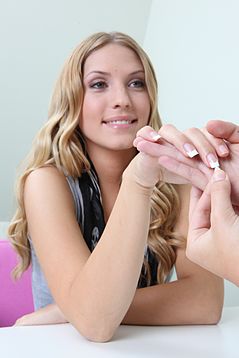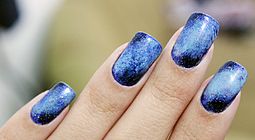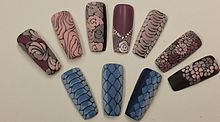Nail art
This articleneeds additional citations forverification.(November 2013) |

Nail artis acreativeway to paint, decorate, enhance, and embellishnails.It is a type of artwork that can be done onfingernailsandtoenails,usually aftermanicuresorpedicures.
History
[edit]
The exact origin of nail treatments is unclear since they appear to have originated in different parts of the world around the same time. Inancient Egypt,from 5000 to 3000 BC, women would dye their nails withhennato indicatesocial statusand seductiveness. Women of thelower class worepasteland neutral shades, while theupper classeswore deep, bright shades. InBabylonia,3200 BC, men, not women, painted their nails with black and greenkohl,an ancient cosmetic. To prepare forwar,warriors of Babylon spent hours having their nails prepared, hair curled, and other similar beauty treatments. As in ancient Egypt, nail color indicated one's status, black fornoblemenand green for the common man. Around the same time, in 3000 BC, the firstnail polishoriginated inancient China.[1]It was made from beeswax, egg whites,gelatin,vegetable dyes,andgum arabic.Chinese dipped their nails in this mixture for several hours or left it on to dry. Colors ranged from pink to red, depending on the mix of the ingredients. During theZhou Dynasty,600 BC, royalty used this simple nail polish withgoldandsilverdust on their nails to show their social status.[citation needed]

TheMing dynasty(1368-1644) was known for extremely long nails.[2]Sometimes, these nails were protected by gold- and jewel-encrusted nail guards.Servantsperformed personal chores for the royals so their nails did not break or become damaged.[3]Empress Dowager Cixiof China, who ruled from 1835 to 1908, was known for her long nails. Many photos show the empress with 6-inch-long gold guards protecting her long nails.[4]A lot of these above did not use nail art as it is widely known today, only stained, dyed, or dusted the fingernails and toenails.[5]The first actual record of nail art was from the short-livedInca Empire(1438-1533), one of the largest empires inSouth America.Incas decorated their nails by paintingeagleson them.[6]In 1770, the first fancy gold and silver manicure sets were created. FrenchKing Louis XVI,who ruled from 1774 until his deposition in 1792, always had his nails taken care of using these sets.[citation needed]
In the early 1800s, the modern manicure developed with the invention of the orange stick, a thin wooden stick with one pointy end, usually made from orange wood.[7]It was invented in 1830, by Dr. Sitts, a Europeanpodiatrist,who adapted a dental tool for manicure purposes. Before this invention, people used acid, a metal rod, and scissors to shape and trim nails. In 1892, Dr. Sitts' niece invented a nail-care line for women of any social class, eventually reaching United States salons.[8]Before then, women had short, almond-shaped nails and often used oils for additional shine or tint. Not long after, in 1907, the first liquid nail polish was invented, although it was colorless. Soon after that, it was available in a variety of different colors.[9]In 1925, the lunar manicure (today known as the half-moon manicure) was seen everywhere. Reds and pinks were used on the nail bed while avoiding the area around the cuticles.[10]Then again in the 1970s, the natural look was back in fashion and preferred by many women, but only for a short time.[11]TheFrench manicurestyle was created in Paris in 1976 by Jeff Pink, the founder of the Los Angeles-based cosmetic company ORLY.[12]Nail painting came back in vogue in the 1980s and has been extremely popular since then.[11]
Types
[edit]Nail art of various types are used to create designs ranging from simple to elaborate.[13]
Traditional nail polish
[edit]The most common type of nail art involves the use oftraditional nail polish.This method is easy to apply and remove, and relatively inexpensive, although it lacks the durability of some other forms and can chip easily.[14]
Acrylic nails
[edit]Acrylic nailsare created using a mixture of acrylic powder and liquid monomer. They provide a more durable and complex design option compared to traditional nail polish, but are also more difficult to apply and remove, and can be more expensive.[15]
Gel nails
[edit]Gel nailsare created using a gel that is cured under UV light. They are similarly durable and complex in design to acrylic nails, but can be more costly. Application and removal processes are similar to those for acrylic nails.[16]
Nail wraps
[edit]Nail wrapsare pre-made designs applied to the nails. They provide a quick and easy method of nail art creation and come in a variety of designs. They can be applied over traditional nail polish or acrylic nails.[17]
Other types
[edit]Other types of nail art include stamping, stenciling, and hand painting.Stampinginvolves the use of a special tool to transfer a design from a stamp to the nail.Stencilinguses a pre-cut stencil to create a design on the nail.Hand paintingutilizes brushes or other tools to create a design on the nail.[18]

Social relevance
[edit]In some cultures, nail art can be tied to the concept of femininity and the sense of belonging in a group of females.[19]While it is mostly women that have nail art, it is increasing in popularity among men.[citation needed]
Nail art is also a way to create its own identity through fashion, using colors and shapes as a disruption of childhood and entering the female teen/adult world, also leaving the influence of their parents to create their selves.[20]
The nail is also part of the puzzle of mounting gender identity; the nails for teenagers and adult women represent a piece of the symbol of what is a woman and how the woman should present herself. Though women use nail art to express their womanliness, the different types define a woman with particular personalities, e.g. French manicure (delicate).[21]
Clipped and filed nails, either on all ten fingers or on theindex and middle fingerof thedominant handin particular, are considered a symbol of queer women after the origin of the practice as a practical measure to allow for safedigital penetrationbetween cisgender women.[22][23]
Media
[edit]
The nail-care industry has been expanding ever since the invention of modern nail polish.[24]Nail art's popularity in media started with the printed press with women's magazines. It had an essential rollout as not a mainstream fashion trend before the 2000s. After the internet age and the everyday use of social media,[25]the trend became prominent subculture among women.[26]Social media made it easier to connect to the mass audience, and with this, people started to share their designs as a way of their creativity and use the nail as their blank canvas. YouTube, Pinterest, Instagram, Tumblr, and Twitter are the major platforms which provide many new ideas and designs for the subculture.[20]However, according to a study,[which?]Pinterest is the most critical platform for recent beauty trends.[citation needed]In 2012, the United States witnessed surging popularity of nail art.[27]
Techniques and tools
[edit]Manicurists start with the same techniques as for themanicureorpedicure:
- Acrylics:a chemical mixture of monomer liquid and polymer powder that can be directly applied on the nails or onartificial nails,also called nail extensions or enhancements.
- Nail gel:a chemical combination similar to acrylics, also known as shellac nails. Manicurist applies several layers on the fingernails or/and toenails and lets it cure under a UV or LED light. When the gel is fixed, it hardens the nails. The gel is also typical in a polish form known as gel polish, and, like other forms of gel, it also requires a UV or LED light to cure. The difference between acrylic and gel is that acrylic dries naturally, but gel needsUV lightto cure. Similarly, where regular nail polish will dry naturally, the gel polish will remain tacky until cured by a UV light.
- Nail polish/nail varnish:a lacquer applied to finger and toenails to protect or as a base color. Nail manicurists also use a base coat to protect and strengthen nails and prevent natural nails from yellowing or staining.
Several options are available for decorating nails:[28]
- Glitters
- Nail art pens
- Piercing
- Stamping
- Water decals
- Water marbling
- Adding accessories
- Studs, rhinestones, miniature plastic bowties, beads, dried flowers, and aluminum foil
- Acrylic powder for 3D art. The 3D acrylic nail art powder is a polymer powder used with a monomer liquid to create designs.
To decorate the nails, manicurists use several tools, such as:
- Nail dotters, also known as "dotting tools."
- Nail art brushes
- Stationery tape/stickers
- Thin, colored striping tape
- Sponges (for gradient effects)
Do-it-yourself(DIY) is a new concept of doing nail art without the aid of experts or professionals. One way to do a DIY design is by using home tools such as toothpicks, earbuds, cellophane tape, etc., or toolsets with dotted tools, brushes, and nail-art pens.
As nail art has evolved, nail artists use acrylic powder to match clients' skin tones when doing specific techniques (Baran, 168).
Innovations
[edit]
Some brands try to innovate by creating new kinds ofnail polish.
- Textures:microbeadsor caviar beads are applied just before the nail polish becomes dry. These textures give a sand-like texture to the nail.
- Holographic effect: When exposed to light, polishes with holographic finishes give off flashy rainbow reflections.

- Velvet manicure: Velvet fibers called velveteen are sprinkled onto wet polish. The excess is gently brushed off, leaving behind a fuzzy velvet feel.
- Crackle effect: Nail polish pioneerSally Hansencreated the first "crackle" effect polish. Acting as an overcoat, a crackle polish is applied onto already-painted nails and dries to a shattered or cracked effect.
- Thermochromic polish: When exposed to hot or cold temperatures, nail polish changes color.
- Matte effect: These nail polishes can transform a layer of glossy nail polish into a flat matte finish.
- Inverse French: Also called a "half-moon." The half-moon is created on the root nail's root in one color while the other is painted differently.
- Nail stickers: A form ofartificial nails,there is an extensive range of nail stickers, strips, and wraps on the market used to mimic nail polish.
Notable nail artists
[edit]References
[edit]- ^Chang, Isabelle Rancier,Gloria."History of Nail Art Design".refinery29.Retrieved2020-02-22.
{{cite web}}:CS1 maint: multiple names: authors list (link) - ^"Nail Art: The Latest Addition to the World of Contemporary Art".artdaily.Retrieved2021-07-24.
- ^"History of Nail Art".Retrieved2016-07-13.
- ^"Powerful Portraits Capture China's Empress Dowager".NPR.org.Retrieved2016-07-18.
- ^Chang, Isabelle Rancier,Gloria."History of Nail Art Design".refinery29.Retrieved2021-07-24.
{{cite web}}:CS1 maint: multiple names: authors list (link) - ^"NAIL ART... THE HISTORY - passion for fresh ideas".2011-12-23.Retrieved2016-07-18.
- ^"the definition of orange stick".Dictionary.Retrieved2016-07-22.
- ^"The History of Nail Care: 1803-2003".Retrieved2016-07-18.
- ^"Nail Polish - Fashion, Costume, and Culture: Clothing, Headwear, Body Decorations, and Footwear through the Ages".fashionencyclopedia.Retrieved2016-07-18.
- ^"History of manicure | Nail Art Journal".nailartjournal.Retrieved2016-07-22.
- ^ab"When Women Started Growing Out and Painting Their Nails".2014-05-19.Retrieved2016-07-18.
- ^"The colorful history of nail polish".The Independent Florida Alligator.Retrieved14 November2013.
- ^"Comprehensive Guide to Nail Art Styles".Acrylic Nails Ideas.Retrieved2023-06-24.
- ^"8 Types on Nail Polish You Should know".L'oreal.Retrieved2023-06-24.
- ^"Comprehensive Guide to Nail Art Styles".Acrylic Nails Ideas.Retrieved2023-06-24.
- ^"Gel Manicures: A Complete Guide to Gel Nails".BYRDIE.Retrieved2023-06-24.
- ^"What are Nail Wraps? Your Complete Guide to Effortless, Picture-Perfect Manicures".Polish Pops.Retrieved2023-06-24.
- ^"Comprehensive Guide to Nail Art Styles".Acrylic Nails Ideas.Retrieved2023-06-24.
- ^BEATTY, E. Sharon; GIVAN, M. Alexa; FRANKE R. George; REYNOLDS E. KRISTY (2015). "Social Store Identity and Adolescent Females' Store Attitudes and Behaviors".Journal of Marketing Theory and Practice.23:1:38–56.doi:10.1080/10696679.2015.980173.S2CID143223280.
- ^abBRITTON, Ann Marie (2012). "University of New Hampshire.The Beauty Industry's Influence on Women in Society".
{{cite journal}}:Cite journal requires|journal=(help) - ^CHITTENDEN, Tara (2010). "Digital dressing up: modelling female teen identity in the discursive spaces of the fashion blogosphere".Journal of Youth Studies.13:4(4): 505–520.doi:10.1080/13676260903520902.S2CID144536848.
- ^Wallace, Megan."Lez nails: Is the 'queer woman with short nails' an outdated stereotype?",DazedBeauty, 17 October 2022. Retrieved 27 June 2024.
- ^Thompson, Martine."Cheers to the Queer Manicure",Los Angeles Times,22 June 2022. Retrieved 27 June 2024.
- ^"Watch How Nail Trends Have Changed in the Past 100 Years".Health News / Tips & Trends / Celebrity Health.2016-05-24.Retrieved2016-07-24.
- ^FRITH, Katherine; SHAW, Ping; CHENG, Hong (2005). "A Cross-Cultural Analysis of Women's Magazine Advertising".Journal of Communication:56–70.doi:10.1111/j.1460-2466.2005.tb02658.x.
- ^"From ancient Egypt to Cardi B: a cultural history of the manicure".the Guardian.2021-01-27.Retrieved2021-07-24.
- ^Grinberg, Emanuella."On main street and the runway, nail art is the new lipstick".
- ^"Nail art trend spurs accessories".Chain Drug Review.24 September 2012.
External links
[edit]- ^Baran, Robert, and Douglas Schoon. "Nail Beauty." Journal of Cosmetic Dermatology, Accepted for publication 21 November 2004, vol. 3, no. 3, 2004, pp. 167–70,https://doi.org/10.1111/j.1473-2130.2004.00141.x. Davis, LaPorchia, et al. "Nail Art, Nail Care and Self Expression: Gender Differences in African Americans' Consumption of Nail Cosmetics." Fashion, Style & Popular Culture, vol. 6, no. 2, 2019, pp. 159–74,https://doi.org/10.1386/fspc.6.2.159_1.
